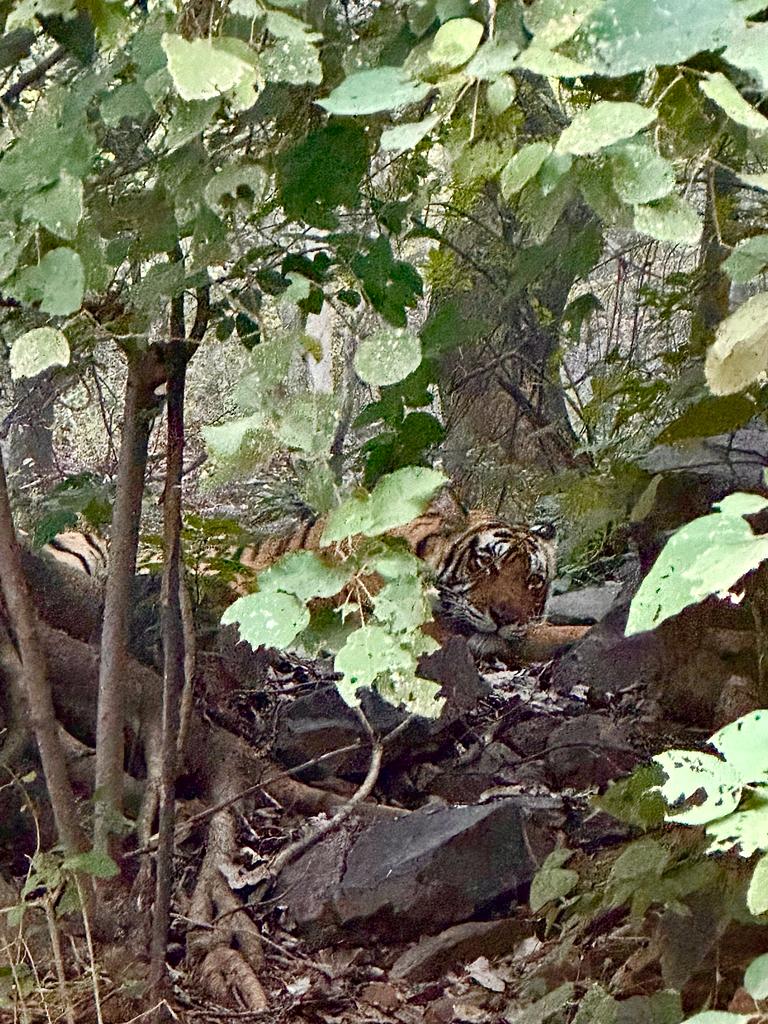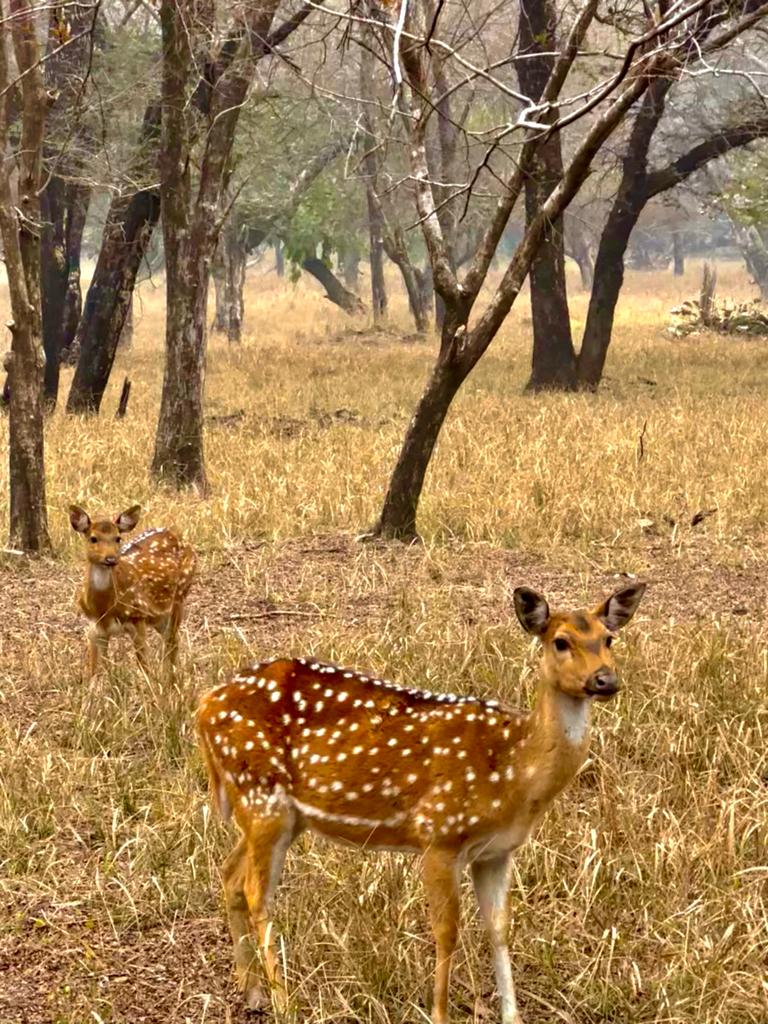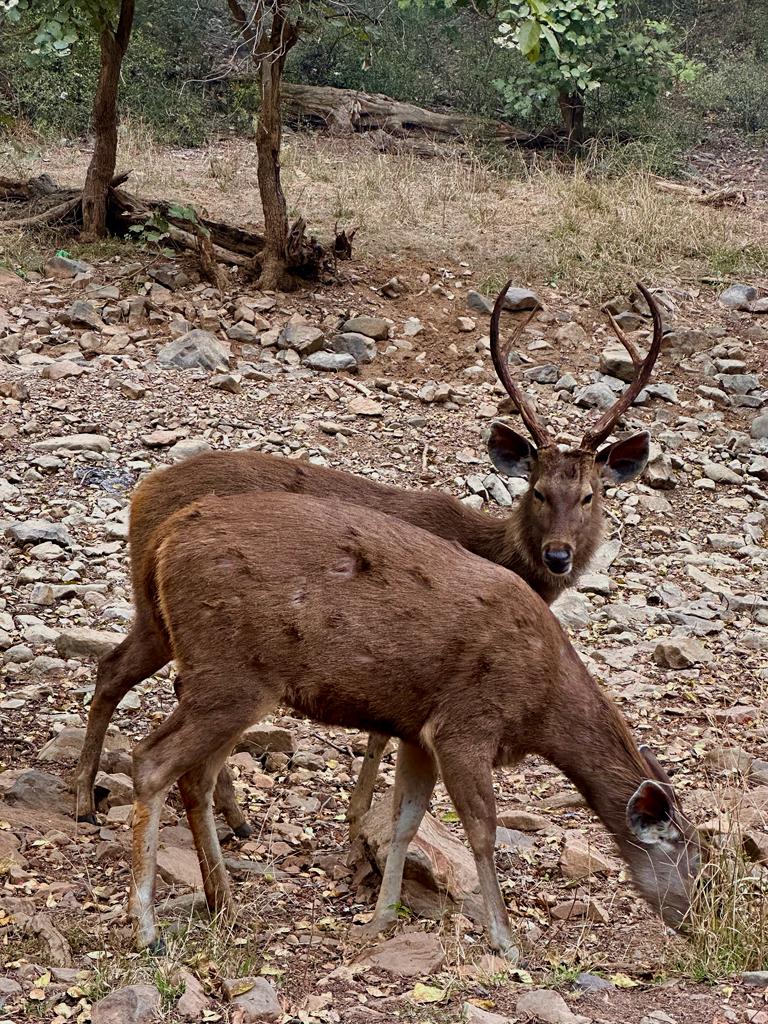Introduction to Tiger Safari in India
A tiger safari in India is an expedition into the heart of nature’s one of the most captivating spectacle. With over 70% of the world’s tiger population, India has become a sanctuary for these majestic creatures, offering a rare opportunity to witness them in their natural habitat.
This guide on ‚tiger safari in India‘ takes you on a journey through the enchanting world of tiger safaris, where each moment is a story waiting to unfold, each turn a potential encounter with the Bengal tiger.
We will explore the best national parks for tiger sightings, the ideal time to visit, the costs involved, and the practicalities of planning such an adventure.
In case you are interested in a 4-week India travel guide, follow this link. For those with less time, we also have a 2-weeks North India travel guide. But now let’s talk about tiger safaris!
- Introduction to Tiger Safari in India
- Which Nationalparks for Tiger Safari in India?
- What is the Best Time for Tiger Safari?
- How Much is a Tiger Safari in India?
- What Are the Chances of Seeing a Tiger?
- How to Dress for a Safari?
- Would I Go on a Tiger Safari at Ranthambore Nationalpark Again?
- Frequently Asked Questions About Tiger Safari in India
- Conclusion About Tiger Safaris in India
Don’t know where to look for cheap flight? WayAway is a flight comparison tool that helps you to find unbeatable deals worldwide. Get the iOS app or android app here or check out the search function down below.
Which Nationalparks for Tiger Safari in India?
When it comes to tiger safaris, India is unparalleled. Home to several renowned national parks, each offers a unique window into the world of the majestic Bengal tiger. Let’s delve into some of the most sought-after destinations for tiger enthusiasts.
Ranthambore National Park
Ranthambore, set in the backdrop of the Aravalli and Vindhya mountain ranges, stands out for its rich history and thriving wildlife. This park is not just about tigers; it’s a tapestry of ancient ruins and diverse ecosystems. The fort standing tall in the park adds a touch of mystique, making your safari an expedition through time.
Kanha National Park
Kanha’s sprawling meadows and dense forests were the muse for Rudyard Kipling’s famous ‚The Jungle Book‘. This park offers a serene setting for tiger spotting, with its lush landscapes and thriving biodiversity.
Bandhavgarh National Park
Bandhavgarh is known for its high density of tigers. The park, once a hunting ground for royalty, now serves as a haven for these big cats, offering some of the best chances for sightings.
Jim Corbett National Park
Named after the legendary hunter-turned-conservationist, Jim Corbett National Park combines rich wildlife with stunning landscapes. It’s a place where the thrill of adventure meets the tranquility of nature.
Each of these parks offers a distinct experience, but they all share one thing: the promise of an encounter with the king of the jungle in its natural realm.
What is the Best Time for Tiger Safari?
Timing is crucial when planning a tiger safari in India. While these majestic creatures roam their territories throughout the year, there are specific months when your chances of sightings increase significantly.
The Ideal Months: October to March
The period from October to March is widely regarded as the best time for tiger safaris in India. These cooler months not only make the safari experience more comfortable but also increase the likelihood of tiger sightings. During these months, tigers tend to be more active throughout the day, especially in the early mornings and late afternoons.
Why Avoid the Monsoon Season?
While the monsoon season, typically from June to September, brings lush greenery and rejuvenates the forests, many zones in the national parks may be inaccessible due to heavy rains and flooding. Moreover, tigers and other wildlife tend to retreat to less accessible areas during this time.
Given the popularity of tiger safaris, it’s crucial to plan your trip well in advance. Booking a safari five months (but at least 2 months!) head is recommended to ensure availability of the best safari zones and to give tour operators ample time to arrange the best possible experience for you.
If you want to read more about the best time to visit India in general, click here.

How Much is a Tiger Safari in India?
A tiger safari in India is an experience of a lifetime, and understanding the costs involved is crucial for planning your adventure. The pricing varies depending on several factors, including the national park you choose, the type of safari, and the service provider.
Direct Booking vs. Tour Operators
Booking directly through the website of a national park like Ranthambore typically costs around 35,000 Indian Rupees (approximately €40). This option often appeals to those who prefer a more self-guided experience.
On the other hand, opting for tour operators like GetYourGuide or Viator can cost a bit more. These operators provide additional services, including guided tours, which can enhance your safari experience.
The higher cost with tour operators can be attributed to the added value they bring. These services often include expert guides who enhance the likelihood of tiger sightings, comfortable transportation, and sometimes even accommodation and meals.
This all-inclusive approach simplifies the process, especially for international travelers or those unfamiliar with the region.
Budgeting for Your Safari
When budgeting for your tiger safari, consider all aspects of the trip, not just the safari cost. This includes transportation to the national park, accommodation, meals, and any additional activities you might want to indulge in during your stay.
What Are the Chances of Seeing a Tiger?
Tiger safaris in India are filled with anticipation and excitement, but the key question on every enthusiast’s mind is: What are the chances of actually spotting a tiger? Let’s explore the likelihood and the factors that influence tiger sightings during a safari.
High Possibility but No Guarantee
While the prospect of seeing a tiger in the wild is high, especially in parks with significant tiger populations, it’s important to remember that sightings are never guaranteed. Tigers are apex predators and masters of camouflage, adept at remaining hidden in their natural habitat.
Safari routes are meticulously planned to traverse areas frequently visited by tigers. Your chances of spotting these magnificent beasts are further enhanced by the expertise of local guides. These guides are not only knowledgeable about tiger behavior and habitats but also stay in constant communication with each other, sharing real-time information about tiger movements and sightings.
Maintaining silence and patience during the safari increases your chances of a sighting. Tigers are sensitive to disturbances, and a quiet, respectful approach to their habitat is crucial.
Each safari is unique, and the unpredictability adds to the thrill. Even if a tiger remains elusive, the experience of being in the wild, amidst the rich flora and fauna of India’s national parks, is a reward in itself.

How to Dress for a Safari?
The right clothing can significantly enhance your tiger safari experience in India. Here are some tips to ensure you’re well-prepared for the adventure:
Bright colors are a no-go in the jungle. Instead, choose clothing in shades that blend with the natural surroundings, like greens and browns. Camouflage prints are also a great option, helping you to merge with the environment and increasing your chances of wildlife sightings.
During the cooler months (October to March), which are ideal for tiger safaris, mornings and evenings can be quite chilly, especially in open safari vehicles. Dressing in layers is advisable, with a heavy jacket for the colder temperatures experienced in the jungle.
Comfort should be your priority. Opt for loose-fitting clothes that allow ease of movement. Durable, breathable fabrics are ideal for the varied terrain and climate of Indian national parks.
Don’t forget hats, sunglasses, and a good sunscreen to protect yourself from the sun. Also, consider wearing sturdy, closed-toe footwear for safety and comfort during the safari. By dressing appropriately, you not only ensure your comfort and safety but also show respect for the wildlife and their habitat.

Would I Go on a Tiger Safari at Ranthambore Nationalpark Again?
After embarking on a tiger safari in Ranthambore National Park, a question lingers – Would I do it again? Reflecting on the experience, my answer is a no, and here’s why:
The highlight of any tiger safari, understandably, is the sighting of the Bengal tiger. However, during my safari, the overwhelming focus on tigers felt limiting. Whenever there was a chance to spot a tiger, even partially hidden behind trees or foliage and several meters away, our vehicle would wait for 10-15 minutes in anticipation. The tigers, often obscured by natural barriers, were a challenge to view clearly.
Contrastingly, encounters with other fauna like deers, chitals, and nilgais were only a minor aspect of the safari. Despite having clear views and opportunities to observe these animals, our stops lasted merely 1 or 2 minutes. It felt like the rangers or other participants do not trink it is worth observing any other animals except for the tigers.
I had hoped for a more comprehensive wildlife experience, where each animal, regardless of its allure or rarity, received equal attention. The safari could have been more enriching by dedicating more time to observe and appreciate the variety of animals that inhabit the park, instead of focusing predominantly on tigers.
Another disadvantage is that we booked with the Nationalpark website instead of tour operators (like GetYourGuide or Viator) which tourists usually do. So we were the only tourists at that day and the guide spoke Hindi 95% of the time, we basically learned nothing about the animals which is very sad. That would not have been the case when we would have booked with a tour agency.
This reflection is not to keep you from the experience of seeing tigers in their natural habitat, which is undoubtedly a unique one. However, for future safaris, I would prefer a more balanced approach that equally values all aspects of the rich biodiversity present in these incredible reserves.
Frequently Asked Questions About Tiger Safari in India
Planning a tiger safari in India can be filled with questions, especially for first-timers. Here are some of the most frequently asked questions to help guide your planning and enhance your experience.
These questions cover the essentials of planning a tiger safari in India, but every journey is unique. Your adventure will be shaped by your choices, expectations, and the unpredictability of nature itself.
Conclusion About Tiger Safaris in India
A tiger safari in India is a wildlife excursion and an immersion into the heart of the wild – an encounter with the spirit of nature. As you drive through the dense forests of India’s national parks, each moment brings with it the promise of something extraordinary.
For those yearning to explore the wild realms of India, a tiger safari offers an adventure like no other. It’s a journey that challenges, inspires, and transforms. Whether it’s your first safari or one of many, the call of the wild is an invitation to witness the majesty of nature in its purest form.
I hope you enjoyed reading this little guide and I could help you on what to be aware of before embarking on a tiger safari! If you need further advice for India, continue reading with our full India travel guide or india veggie food guide or feel free to reach out to me at my socials.
I hope to see you again soon on this blog. Do not forget to share this guide on tiger safari in India with your friends and family too 🙂





